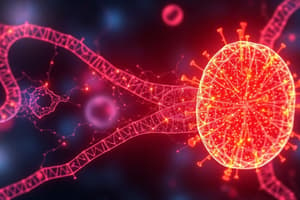Podcast
Questions and Answers
Which of the following is NOT a level of protein structure?
Which of the following is NOT a level of protein structure?
- Secondary
- Tertiary
- Octet (correct)
- Primary
What is the term for the disruption in folding or shape of a protein?
What is the term for the disruption in folding or shape of a protein?
- Classification
- Catalysis
- Denaturation (correct)
- Specificity
Which of the following can cause protein denaturation?
Which of the following can cause protein denaturation?
- Strong acids or bases
- Organic solvents
- Salts
- All of the above (correct)
What type of bonds within proteins can be disrupted by heavy metal ions?
What type of bonds within proteins can be disrupted by heavy metal ions?
Which of the following heavy metals can denature proteins based on charge?
Which of the following heavy metals can denature proteins based on charge?
What type of amino acid side chain can heavy metals like mercury and lead bind to?
What type of amino acid side chain can heavy metals like mercury and lead bind to?
Which of the following interactions within a protein would be disrupted by heavy metals?
Which of the following interactions within a protein would be disrupted by heavy metals?
Which of the following is NOT a way in which cofactors and coenzymes can help enzymes speed up reactions?
Which of the following is NOT a way in which cofactors and coenzymes can help enzymes speed up reactions?
What effect does temperature have on enzyme activity?
What effect does temperature have on enzyme activity?
Which types of bonds between the enzyme and substrate would potentially be disrupted by a change in pH?
Which types of bonds between the enzyme and substrate would potentially be disrupted by a change in pH?
What is the function of a lysosome?
What is the function of a lysosome?
At what pH are lysosomal enzymes active?
At what pH are lysosomal enzymes active?
What type of enzyme modification alter the structure of an enzyme making or breaking covalent bonds?
What type of enzyme modification alter the structure of an enzyme making or breaking covalent bonds?
What is the main type of covalent modification that can alter the structure of an enzyme?
What is the main type of covalent modification that can alter the structure of an enzyme?
Which of the following is the basis of lead poisoning?
Which of the following is the basis of lead poisoning?
Enzymes speed up a reaction by lowering the __________ of the reaction.
Enzymes speed up a reaction by lowering the __________ of the reaction.
The highest energy configuration formed when changing from reactants to products is called the __________.
The highest energy configuration formed when changing from reactants to products is called the __________.
Enzymes are highly specific because __________.
Enzymes are highly specific because __________.
Which amino acid side chain can easily function as an acid or a base?
Which amino acid side chain can easily function as an acid or a base?
Which nucleophilic side groups can form a temporary covalent bond with the substrate in enzyme active sites?
Which nucleophilic side groups can form a temporary covalent bond with the substrate in enzyme active sites?
What is the role of magnesium in glycolytic enzymes involving ATP?
What is the role of magnesium in glycolytic enzymes involving ATP?
Which enzyme catalyzes the phosphorylation in glycogen metabolism?
Which enzyme catalyzes the phosphorylation in glycogen metabolism?
Which enzyme is inhibited by covalent modification in glycogen metabolism?
Which enzyme is inhibited by covalent modification in glycogen metabolism?
What type of modification is involved in irreversible covalent modification of enzymes?
What type of modification is involved in irreversible covalent modification of enzymes?
Which type of modification changes the conformation and activity of the enzyme by binding to its allosteric site?
Which type of modification changes the conformation and activity of the enzyme by binding to its allosteric site?
What is the effect of an effector molecule binding to an allosteric enzyme?
What is the effect of an effector molecule binding to an allosteric enzyme?
Which enzyme is allosterically inhibited by high levels of ATP?
Which enzyme is allosterically inhibited by high levels of ATP?
Which enzyme is allosterically activated by high levels of AMP?
Which enzyme is allosterically activated by high levels of AMP?
What is the purpose of compartmentalization of enzymes via membrane-bound organelles?
What is the purpose of compartmentalization of enzymes via membrane-bound organelles?
At what pH do lysosomal enzymes function?
At what pH do lysosomal enzymes function?
What is the term for the disruption in folding or shape of a protein?
What is the term for the disruption in folding or shape of a protein?
Which of the following interactions within a protein would be disrupted by heavy metals?
Which of the following interactions within a protein would be disrupted by heavy metals?
What is the function of a lysosome?
What is the function of a lysosome?
Which amino acid side chain can easily function as an acid or a base?
Which amino acid side chain can easily function as an acid or a base?
What type of amino acid side chain can heavy metals like mercury and lead bind to?
What type of amino acid side chain can heavy metals like mercury and lead bind to?
At what pH do lysosomal enzymes function?
At what pH do lysosomal enzymes function?
Which of the following is the basis of lead poisoning?
Which of the following is the basis of lead poisoning?
Which of the following can cause protein denaturation?
Which of the following can cause protein denaturation?
Which type of protein is generally long and rod-shaped, providing strength and often insoluble in water?
Which type of protein is generally long and rod-shaped, providing strength and often insoluble in water?
Which type of protein is generally compact and spherical, often soluble in water, and has dynamic functions such as catalyzing reactions?
Which type of protein is generally compact and spherical, often soluble in water, and has dynamic functions such as catalyzing reactions?
Which level of protein structure refers to the linear sequence of amino acids in a protein?
Which level of protein structure refers to the linear sequence of amino acids in a protein?
Which level of protein structure refers to the folding and twisting of the polypeptide chain due to hydrogen bonding between amino acids?
Which level of protein structure refers to the folding and twisting of the polypeptide chain due to hydrogen bonding between amino acids?
Which level of protein structure refers to the overall 3D arrangement of a single polypeptide chain?
Which level of protein structure refers to the overall 3D arrangement of a single polypeptide chain?
Which level of protein structure refers to the arrangement of multiple polypeptide chains in a protein complex?
Which level of protein structure refers to the arrangement of multiple polypeptide chains in a protein complex?
What is the term for the process of unfolding or disruption in the shape of a protein, resulting in loss of function?
What is the term for the process of unfolding or disruption in the shape of a protein, resulting in loss of function?
Which type of catalysis involves the transfer of a proton from an acid to a base?
Which type of catalysis involves the transfer of a proton from an acid to a base?
Which type of catalysis involves the formation of a covalent bond between the enzyme and substrate?
Which type of catalysis involves the formation of a covalent bond between the enzyme and substrate?
What are small molecules or ions that are required for the proper functioning of some enzymes called?
What are small molecules or ions that are required for the proper functioning of some enzymes called?
Flashcards are hidden until you start studying





